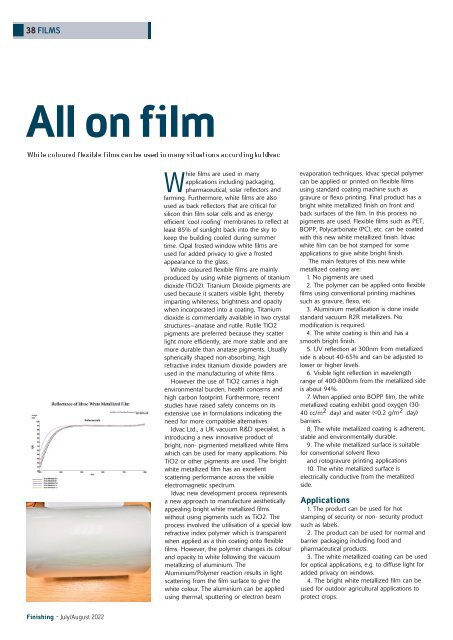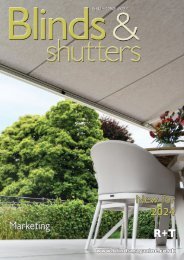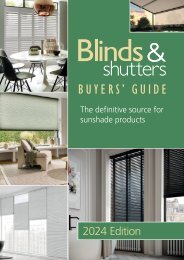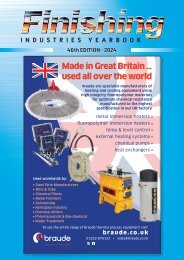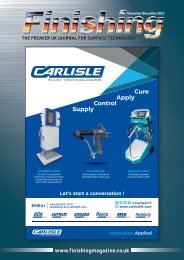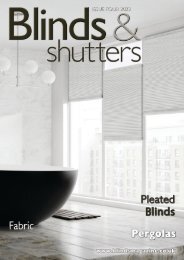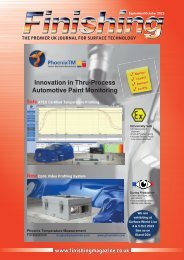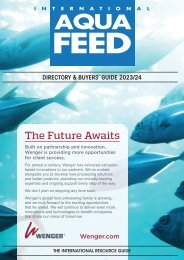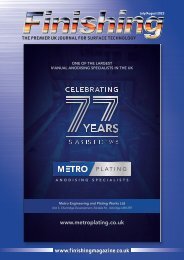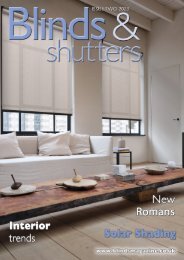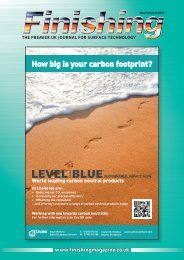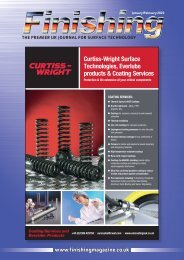Finishing - July-August 2022
This issue has the winners of the galvanizing industry awards, plus an update on the new Carlisle innovation centre. There is also a report from the BCF conference and a review of the Qualicoat conference with took place in London a few weeks ago. It’s great to see that in person events are taking place and that people are excited to go. Long may this continue!
This issue has the winners of the galvanizing industry awards, plus an update on the new Carlisle innovation centre. There is also a report from the BCF conference and a review of the Qualicoat conference with took place in London a few weeks ago. It’s great to see that in person events are taking place and that people are excited to go. Long may this continue!
You also want an ePaper? Increase the reach of your titles
YUMPU automatically turns print PDFs into web optimized ePapers that Google loves.
38 FILMS<br />
All on film<br />
White films are used in many<br />
applications including packaging,<br />
pharmaceutical, solar reflectors and<br />
farming. Furthermore, white films are also<br />
used as back reflectors that are critical for<br />
silicon thin film solar cells and as energy<br />
efficient ‘cool roofing’ membranes to reflect at<br />
least 85% of sunlight back into the sky to<br />
keep the building cooled during summer<br />
time. Opal frosted window white films are<br />
used for added privacy to give a frosted<br />
appearance to the glass.<br />
White coloured flexible films are mainly<br />
produced by using white pigments of titanium<br />
dioxide (TiO2). Titanium Dioxide pigments are<br />
used because it scatters visible light, thereby<br />
imparting whiteness, brightness and opacity<br />
when incorporated into a coating. Titanium<br />
dioxide is commercially available in two crystal<br />
structures—anatase and rutile. Rutile TiO2<br />
pigments are preferred because they scatter<br />
light more efficiently, are more stable and are<br />
more durable than anatase pigments. Usually<br />
spherically shaped non-absorbing, high<br />
refractive index titanium dioxide powders are<br />
used in the manufacturing of white films.<br />
However the use of TiO2 carries a high<br />
environmental burden, health concerns and<br />
high carbon footprint. Furthermore, recent<br />
studies have raised safety concerns on its<br />
extensive use in formulations indicating the<br />
need for more compatible alternatives.<br />
Idvac Ltd., a UK vacuum R&D specialist, is<br />
introducing a new innovative product of<br />
bright, non- pigmented metallized white films<br />
which can be used for many applications. No<br />
TiO2 or other pigments are used. The bright<br />
white metallized film has an excellent<br />
scattering performance across the visible<br />
electromagnetic spectrum.<br />
Idvac new development process represents<br />
a new approach to manufacture aesthetically<br />
appealing bright white metallized films<br />
without using pigments such as TiO2. The<br />
process involved the utilisation of a special low<br />
refractive index polymer which is transparent<br />
when applied as a thin coating onto flexible<br />
films. However, the polymer changes its colour<br />
and opacity to white following the vacuum<br />
metallizing of aluminium. The<br />
Aluminium/Polymer reaction results in light<br />
scattering from the film surface to give the<br />
white colour. The aluminium can be applied<br />
using thermal, sputtering or electron beam<br />
evaporation techniques. Idvac special polymer<br />
can be applied or printed on flexible films<br />
using standard coating machine such as<br />
gravure or flexo printing. Final product has a<br />
bright white metallized finish on front and<br />
back surfaces of the film. In this process no<br />
pigments are used. Flexible films such as PET,<br />
BOPP, Polycarbonate (PC), etc. can be coated<br />
with this new white metallized finish. Idvac<br />
white film can be hot stamped for some<br />
applications to give white bright finish.<br />
The main features of this new white<br />
metallized coating are:<br />
1. No pigments are used.<br />
2. The polymer can be applied onto flexible<br />
films using conventional printing machines<br />
such as gravure, flexo, etc.<br />
3. Aluminium metallization is done inside<br />
standard vacuum R2R metallizers. No<br />
modification is required.<br />
4. The white coating is thin and has a<br />
smooth bright finish.<br />
5. UV reflection at 300nm from metallized<br />
side is about 40-65% and can be adjusted to<br />
lower or higher levels.<br />
6. Visible light reflection in wavelength<br />
range of 400-800nm from the metallized side<br />
is about 94%.<br />
7. When applied onto BOPP film, the white<br />
metallized coating exhibit good oxygen (30-<br />
40 cc/m 2 .day) and water (


